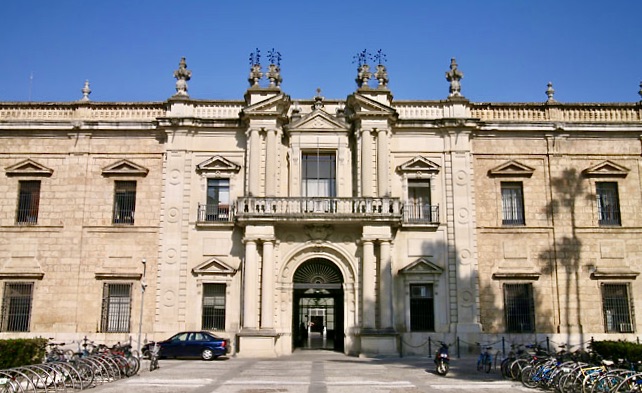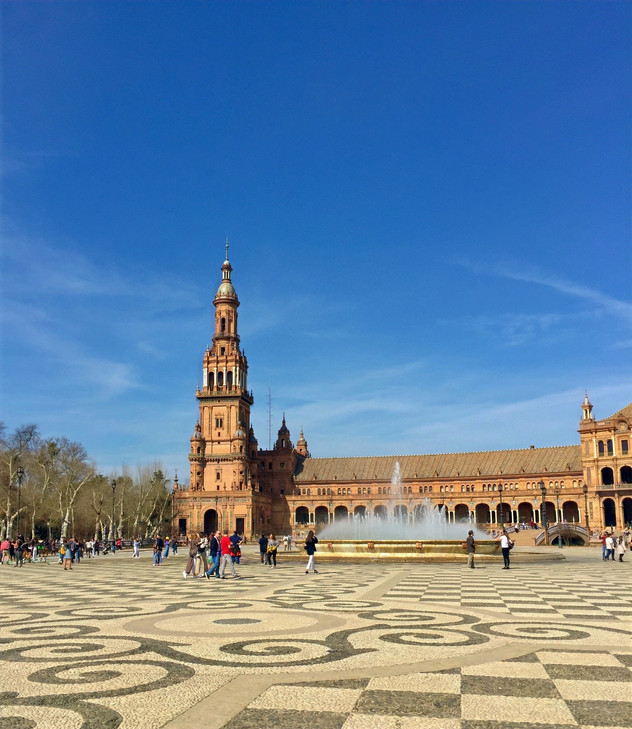Seville - Part 2 - the setting for Carmen and the Stunning Plaza de Espana
- Fiona
- May 31, 2020
- 5 min read
Updated: Aug 7, 2020
The penultimate stop on our walking tour was at the former Royal Tobacco Factory (Real Fabrica de Tabacos Seville) that is now (and has been since 1949) part of the University of Seville.
Tobacco in Seville
Tobacco was one of the first plants which Columbus discovered on his arrival in the New World. When he took the plants back to Seville in the 16th century it led to the establishment of tobacco merchants in the city.
In 1778 in order to facilitate state control of the production of tobacco products and to ensure adequate hygiene standards King Fernando VI founded the Royal Tobacco Factory - it was completed in 1771. At the time it was the second largest building in Spain and today takes up an entire city block;
The factory was built outside the city walls on the land known as de las calaveras ("of the skulls") because it had been the site of an Ancient Roman burial ground.
It established a royal monopoly on the tobacco trade - a trade that was incredibly lucrative to the royals and lasted for more than a century.
Production at the factory began in 1758, with 1,000 men employed, and horses to turn the mills which ground tobacco into polvo or rape (snuff), which was still in fashion when construction started in the 1730s. Later cigars were produced, initially the workers were all men but later women were employed to roll them. (the women could be paid less and their work was of a higher standard). By the late 1800s, the entire workforce was women - 6,000 at its peak according to some sources. With mechanization, this was reduced to 1,000 by the 1940s.
18th century Industrial Architecture
The immense size of the building together with the baroque entrance and a renaissance style layout in terms of its floor plan and facades give the building a palatial look. It is made from stone and had a moat to protect the tobacco. There are finials on the roof and lots of locally made tiles.
Carmen
Irene, our guide, also mentioned that this Royal Tobacco Factorywa was the setting for the opera of Carmen by Georges Bizet. The opera is based on the 1845 novella by French dramatist Prosper Mérimée and takes place in Seville during the mid 19th century where Carmen, a gypsy woman worked in this factory as a cigarrera (cigarette girl).
Plaza de Espana
Irene saved the best stop until last - this has to one of the most beautiful public spaces I have ever seen - and like so many of the grand buildings in Seville it is a blend of Baroque, Renaissance and Moor architectural styles, unlike most of the buildings in Seville, it is actually less than 100 years old!
We entered the complex through one of the towers and made our way up to an open gallery where, as we looked out over the plaza, Irene told us about when and why this Plaza De Espana was built in Seville...
The Plaza De Espana was built as the jewel in the crown at the Ibero-American Exposition in Seville in 1929. The objective of the exposition was to bring Spain together with its former Latin American colonies by sharing culture and promoting positive relationships among the participating countries. The Plaza Espana was built to showcase Spain’s accomplishments in architecture and industry.
Unfortunately it fell into a state of disrepair during the later part of the 20th century when during a period of abandonment its original shape deteriorated due to neglect and vandalism. (Vandals had ripped off a lot of the tiles and other ceramic ornaments.) Then fortunately the City Council (with state funding) led a major renovation project in 2008 which was completed in 2010 and has returned it to its original glory as well as adding improvements such as lighting and a water treatment system for the canal.
A design that is full of symbolism...
The plaza was designed to be a semicircular shape representing the embrace of Spain and its ancient colonies, the building points in the direction of the New World and the countries Spain once ruled over there. The idea of this particular form is that if you stand right in the middle of the plaza, taking in the exquisite detail through your own eyes, it will seem like the plaza is hugging you. Supposedly the feeling comes from the of the central building having two symmetrical arms that end in two towers, named South Tower and North Tower...(In a city of low rise buildings These towers, like the Giralda of the Seville Cathedral, can be seen from all over Seville).
This complex is stunning, it's grandeur is illustrated by the beautiful colonnaded galleries that connect the towers at each end of the complex to the central part of the building. The galleries curve to give the plaza its semicircular shape. The extensive paving of the plaza is softened by a large central fountain and a curving canal that has four bridges that connect the plaza with the wide promenade that runs along the front of the building. The bridges are decorated with beautiful locally made (in Triana) ceramic tiles.
Today the building houses various government offices, including the one that we visited on every day of the following week to apply for our ID document, the NIE (Numero de Identificacion de Extranjero). Our application was approved but the card was to have taken three weeks to issue and unfortunately, due to the current global pandemic, we were not been able to collect it. Hopefully we won't have to begin the process again when we return!
Having worked in Immigration in New Zealand and seen many immigration offices around the world I have to say that the Spanish Immigration office building in Seville has to be the most beautiful Immigration Office building in the world!
Plaza de España is located in María Luisa Park, a gigantic urban park that encompases the entire southern end of the city. It was designed with Moorish influences so it is filled with gardens, flowers, fountains, palm trees and orange trees. There are also multiple pavilions throughout the park that were also constructed for the World Fair, showcasing some of the other Latin American countries.
As we left the plaza through the tower again we were treated to flamenco street performers - a dancer and guitar player. Okay - it was a bit of a tourist trap but it was so wonderful to see in such a fabulous setting!
Images
1 Panorama of most of the Plaza de Espana
2 A view from the gallery - so many tourists!
3 Irene - doing her stuff
4 The gorgeous moorish ceiling tiles in the gallery
5 A closer view of the ceiling and out to the tiles on one of the towers
6 The gallery with no people (we were there very early during the following week to queue to get into immigration:)
7,8 Views of the Plaza from the gallery
9 Bridge over the canal and one of the towers
10,12 views of the fountain
13,14 Some of the tiles decorating the bridges
15 Us!
16 Street performers - flamenco








































Such a beautiful place - we took our lunch and picnicked on the grass!